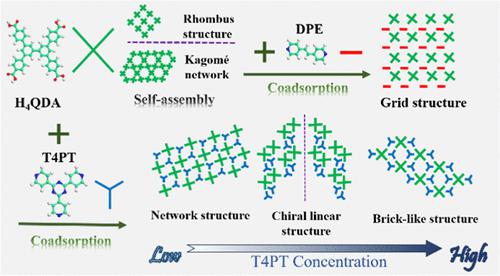Our official English website, www.x-mol.net, welcomes your
feedback! (Note: you will need to create a separate account there.)
Symmetry of Pyridine Derivatives Controlled Two-Dimensional Nanostructural Diversity by Co-Assembly with Aromatic Carboxylic Acids
Langmuir ( IF 3.7 ) Pub Date : 2024-03-12 , DOI: 10.1021/acs.langmuir.3c04009 Yutuo Zheng 1 , Songyao Zhang 1 , Xiaoyang Zhao 1 , Xinrui Miao 1 , Wenli Deng 1
Langmuir ( IF 3.7 ) Pub Date : 2024-03-12 , DOI: 10.1021/acs.langmuir.3c04009 Yutuo Zheng 1 , Songyao Zhang 1 , Xiaoyang Zhao 1 , Xinrui Miao 1 , Wenli Deng 1
Affiliation

|
The self-assembly behaviors of aromatic carboxylic acids are commonly investigated at the liquid/solid interfaces because of their rigid skeletons and both hydrogen-bond donors and receptors. However, self-assemblies of aromatic carboxylic acids with low symmetry and interactions between carboxylic acid and pyridine derivatives are worth exploring. In this work, the self-assembled structural transitions of a kind of low-symmetric aromatic carboxylic acid (H4QDA) are regulated by the coadsorption of two pyridine derivatives (DPE and T4PT) with different symmetry, which are investigated by scanning tunneling microscopy under ambient conditions. For the H4QDA/DPE system, the grid structure appears. For the H4QDA/T4PT system, the coassembled morphologies display an obvious concentration dependence. With the increase of solution concentration of T4PT, three coassembled patterns (network structure, chiral linear structure, and brick-like structure) are observed. Corresponding structural models suggest that the O–H···N hydrogen bonds have great contributions to stabilizing these coassembled structures. Our studies will help to explore the complexity, diversity, and functionality of multiple component systems and are conducive to further understanding the underlying mechanisms in the assembly process.
中文翻译:

吡啶衍生物与芳香族羧酸共组装控制二维纳米结构多样性的对称性
由于芳香族羧酸具有刚性骨架以及氢键供体和受体,因此通常在液/固界面上研究芳香族羧酸的自组装行为。然而,低对称性芳香族羧酸的自组装以及羧酸与吡啶衍生物之间的相互作用值得探索。在这项工作中,一种低对称芳香族羧酸(H 4 QDA)的自组装结构转变是通过两种不同对称性的吡啶衍生物(DPE和T4PT)的共吸附来调节的,并通过扫描隧道显微镜进行了研究在环境条件下。对于H 4 QDA/DPE 系统,出现网格结构。对于H 4 QDA/T4PT系统,共组装形貌表现出明显的浓度依赖性。随着T4PT溶液浓度的增加,观察到三种共组装模式(网络结构、手性线性结构和砖状结构)。相应的结构模型表明O–H·N氢键对稳定这些共组装结构有很大贡献。我们的研究将有助于探索多组件系统的复杂性、多样性和功能性,并有利于进一步理解装配过程中的潜在机制。
更新日期:2024-03-12
中文翻译:

吡啶衍生物与芳香族羧酸共组装控制二维纳米结构多样性的对称性
由于芳香族羧酸具有刚性骨架以及氢键供体和受体,因此通常在液/固界面上研究芳香族羧酸的自组装行为。然而,低对称性芳香族羧酸的自组装以及羧酸与吡啶衍生物之间的相互作用值得探索。在这项工作中,一种低对称芳香族羧酸(H 4 QDA)的自组装结构转变是通过两种不同对称性的吡啶衍生物(DPE和T4PT)的共吸附来调节的,并通过扫描隧道显微镜进行了研究在环境条件下。对于H 4 QDA/DPE 系统,出现网格结构。对于H 4 QDA/T4PT系统,共组装形貌表现出明显的浓度依赖性。随着T4PT溶液浓度的增加,观察到三种共组装模式(网络结构、手性线性结构和砖状结构)。相应的结构模型表明O–H·N氢键对稳定这些共组装结构有很大贡献。我们的研究将有助于探索多组件系统的复杂性、多样性和功能性,并有利于进一步理解装配过程中的潜在机制。

































 京公网安备 11010802027423号
京公网安备 11010802027423号